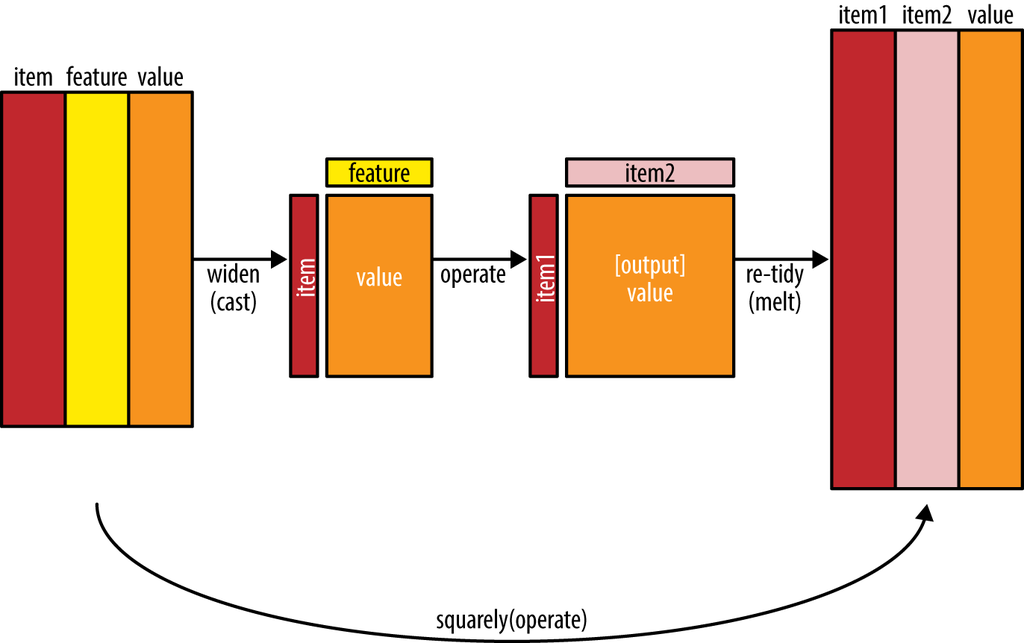| Sitzung | Datum | Thema (synchron) | Übung (asynchron) | Dozent:in |
|---|---|---|---|---|
| 1 | 18.04.2024 | Einführung & Überblick | R-Einführung | AM & CA |
| 2 | 📚 | Teil 1: Systematic Review | R-Einführung | AM |
| 3 | 25.04.2024 | Einführung in Systematic Reviews I | R-Einführung | AM |
| 4 | 02.05.2024 | Einführung in Systematic Reviews II | R-Einführung | AM |
| 5 | 09.05.2024 | 🏖️ Feiertag | R-Einführung | ED |
| 6 | 16.05.2024 | Automatisierung von SRs & KI-Tools | R-Einführung | AM |
| 7 | 23.05.2024 | 🍻 WiSo-Projekt-Woche | R-Einführung | CA |
| 8 | 04.06.2024 | 🍕 Gastvortrag: Prof. Dr. Emese Domahidi | zur Sitzung | CA |
| 9 | 06.06.2024 | Automatisierung von SRs & KI-Tools | zur Sitzung | CA |
| 10 | 💻 | Teil 2: Text as Data & Unsupervised Machine Learning | zur Sitzung | CA & AM |
| 11 | 13.06.2024 | Introduction to Text as Data | zur Sitzung | CA & AM |
| 12 | 20.06.2024 | Text processing | zur Sitzung | CA & AM |
| 1 | 27.06.2024 | Unsupervised Machine Learning I | zur Sitzung | AM & CA |
| 2 | 04.07.2024 | Unsupervised Machine Learning II | R-Einführung | AM |
| 3 | 11.07.2024 | Recap & Ausblick | R-Einführung | AM |
| 4 | 18.07.2024 | 🏁 Semesterabschluss | R-Einführung | AM |
Text processing
Sitzung 08
20.06.2024
Seminarplan
Agenda
Organisation & Koordination
Umorganisation der Kurs-Seite
From Text to Data
Grundbegriffe und Prozess der Texttransformation
Building a shared vocabulary
Wichtige Begriffe und Konzepte

A “bag of words”
Einfache Technik im Natural Language Processing (NLP)
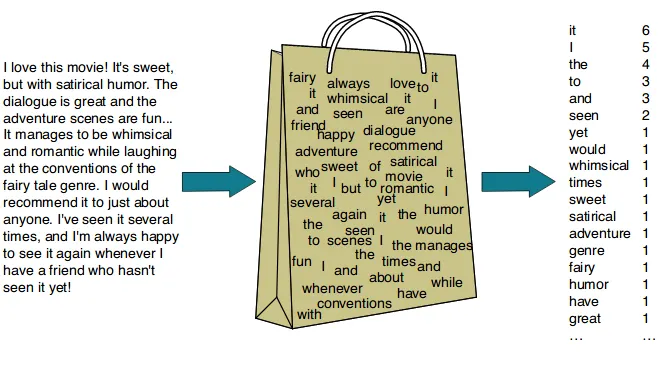
- a collection of words, disregarding grammar, word order, and context.
Digitales Wörterbuch der deutschen Sprache
Großes, frei verfügbares & deutschsprachiges Textkorpora
Vom Korpus zum Token
Einfaches Beispiel zur Darstellung der verschiedenen Konzepte
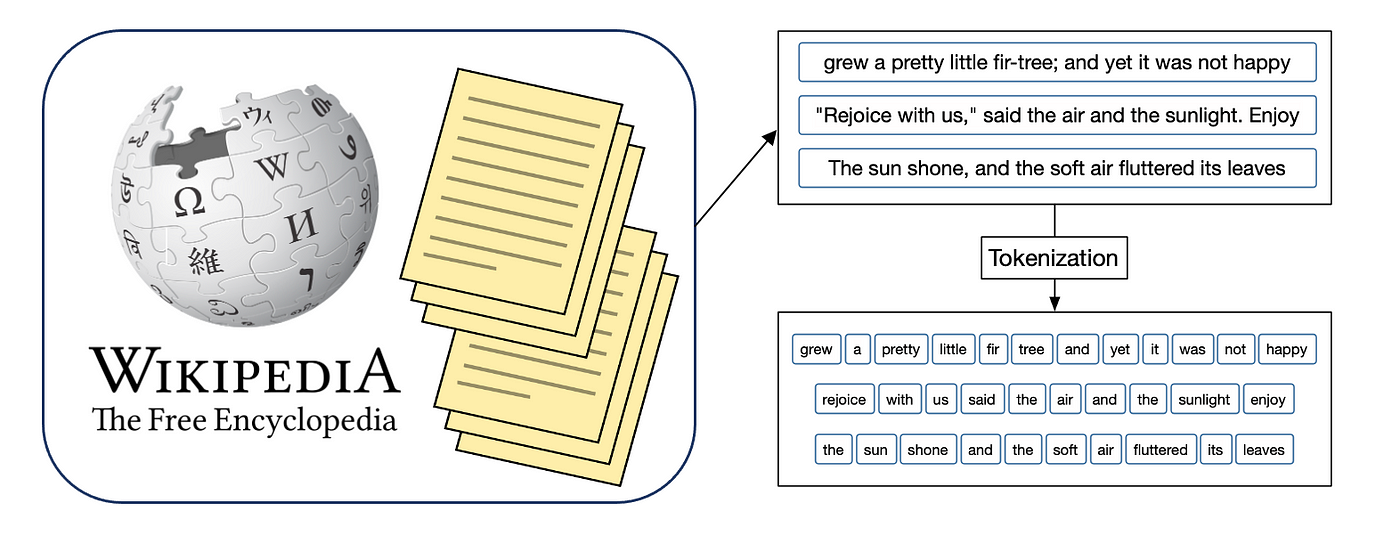
Vom Korpus zum Token zum Model
Komplexer Prozess der Textverarbeitung
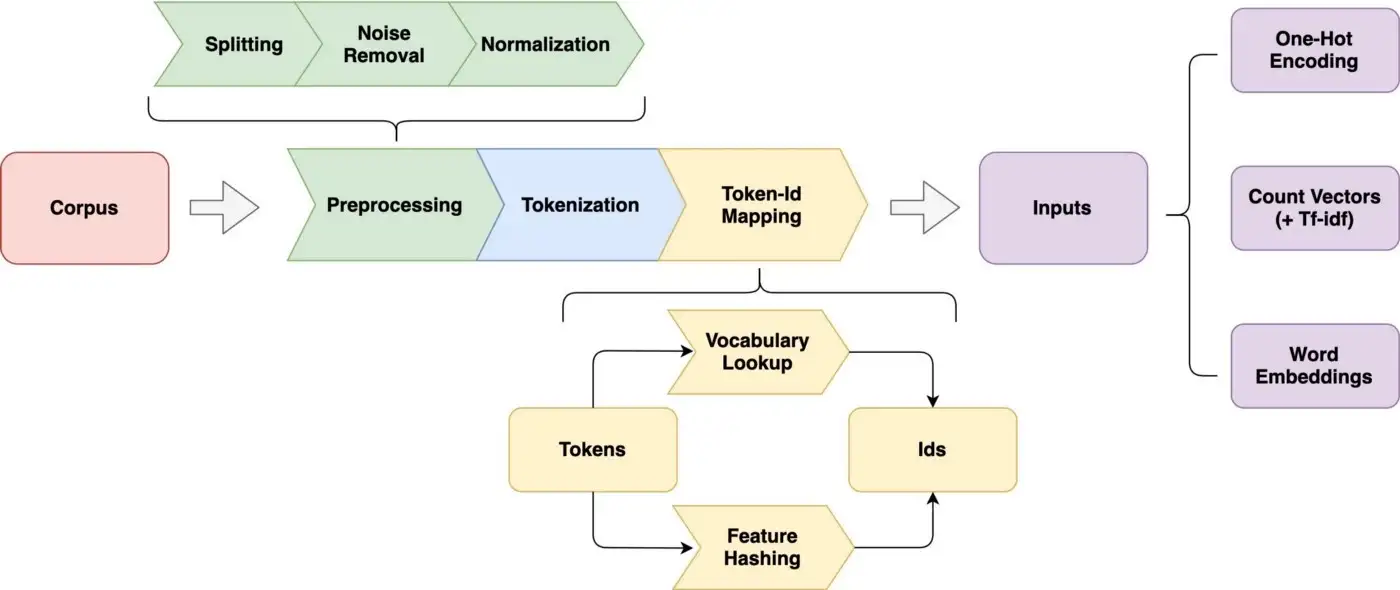
by Jiawei Hu
Sätze ➜ Token ➜ Lemma ➜ POS
Beispielhafte Darstellung des Text Preprocessing
1. Satzerkennung
Was gibt’s in New York zu sehen?
2. Tokenisierung
was; gibt; `s; in; new; york; zu; sehen; ?
3. Lemmatisierung
was; geben; `s; in; new; york; zu; sehen; ?
4. Part-Of-Speech (POS) Tagging
>Was/PWS >gibt/VVFIN >’s/PPER >in/APPR >New/NE >York/NE >zu/PTKZU >sehen/VVINF
Von BoW zu DFM
Transformation des Bag-of-Words (BOW) zur Document-Feature-Matrix (DFM)

Text as data in R
Einführung in die Textanalyse mit tidytext
What we did so far
Informationen zur Datengrundlage und -quelle
- Suche nach Literatur zur (Sytematischen) Literaturüberblicken auf OpenAlex
- Download von knapp 100.000 Literaturverweisen via API mit openalexR (Aria et al., 2024)
- Deskriptive Auswertung der Daten (“Rekonstruktion” des OpenAlex Web-Dashboards) mit R
Heutige Ziele:
- Eingrenzung der Datenbasis für weiterführende Analysen
- Anwendung einfacher Textanalyseverfahren zur Untersuchung der Abstracts
Euer Input ist gefragt!
Wie sollen die Daten weiter eingegrenzt werden?
Bitte scannt den QR-Code oder nutzt den folgenden Link für die Teilnahme an einer kurzen Umfrage:
Temporary Access Code: 3332 2971
01:00
Ergebnis
Build the subsample
Fokus auf englische Artikel aus den Sozialwissenschaften und der Psychologie
review_subsample <- review_works_correct %>%
# Eingrenzung: Sprache und Typ
filter(language == "en") %>%
filter(type == "article") %>%
# Datentranformation
unnest(topics, names_sep = "_") %>%
filter(topics_name == "field") %>%
filter(topics_i == "1") %>%
# Eingrenzung: Forschungsfeldes
filter(
topics_display_name == "Social Sciences"|
topics_display_name == "Psychology"
)Expand for full code
review_works_correct %>%
mutate(
included = ifelse(id %in% review_subsample$id, "Ja", "Nein"),
included = factor(included, levels = c("Nein", "Ja"))
) %>%
ggplot(aes(x = publication_year_fct, fill = included)) +
geom_bar() +
labs(
x = "",
y = "Anzahl der Einträge",
fill = "In Subsample enthalten?"
) +
scale_fill_manual(values = c("#A0ACBD50", "#FF707F")) +
theme_pubr() 
Explore abstracts
Tidy data principles als Grundlage für Analyse-Workflow

- Tidy data struture (each variable is column, each observation a row, each value is a cell, each type of observaional unit is a table) results in a table with one-token-per-row (Silge & Robinson, 2017).
Tokenization der Abstracts
Transform data to tidy text
# Create tidy data
review_tidy <- review_subsample %>%
# Tokenization
tidytext::unnest_tokens("text", ab) %>%
# Remove stopwords
filter(!text %in% tidytext::stop_words$word)
# Preview
review_tidy %>%
select(id, text) %>%
print(n = 10)# A tibble: 4,880,965 × 2
id text
<chr> <chr>
1 https://openalex.org/W4293003987 5
2 https://openalex.org/W4293003987 item
3 https://openalex.org/W4293003987 world
4 https://openalex.org/W4293003987 health
5 https://openalex.org/W4293003987 organization
6 https://openalex.org/W4293003987 index
7 https://openalex.org/W4293003987 5
8 https://openalex.org/W4293003987 widely
9 https://openalex.org/W4293003987 questionnaires
10 https://openalex.org/W4293003987 assessing
# ℹ 4,880,955 more rowsBefore and after the transformation
Vergleich eines Abstraktes in Rohform und nach Tokenisierung
[1] "The 5-item World Health Organization Well-Being Index (WHO-5) is among the most widely used questionnaires assessing subjective psychological well-being. Since its first publication in 1998, the WHO-5 has been translated into more than 30 languages and has been used in research studies all over the world. We now provide a systematic review of the literature on the WHO-5.We conducted a systematic search for literature on the WHO-5 in PubMed and PsycINFO in accordance with the PRISMA guidelines. In our review of the identified articles, we focused particularly on the following aspects: (1) the clinimetric validity of the WHO-5; (2) the responsiveness/sensitivity of the WHO-5 in controlled clinical trials; (3) the potential of the WHO-5 as a screening tool for depression, and (4) the applicability of the WHO-5 across study fields.A total of 213 articles met the predefined criteria for inclusion in the review. The review demonstrated that the WHO-5 has high clinimetric validity, can be used as an outcome measure balancing the wanted and unwanted effects of treatments, is a sensitive and specific screening tool for depression and its applicability across study fields is very high.The WHO-5 is a short questionnaire consisting of 5 simple and non-invasive questions, which tap into the subjective well-being of the respondents. The scale has adequate validity both as a screening tool for depression and as an outcome measure in clinical trials and has been applied successfully across a wide range of study fields."review_tidy %>%
filter(id == "https://openalex.org/W4293003987") %>%
pull(text) %>%
paste(collapse = " ")[1] "5 item world health organization index 5 widely questionnaires assessing subjective psychological publication 1998 5 translated 30 languages research studies world provide systematic review literature 5 conducted systematic search literature 5 pubmed psycinfo accordance prisma guidelines review identified articles focused aspects 1 clinimetric validity 5 2 responsiveness sensitivity 5 controlled clinical trials 3 potential 5 screening tool depression 4 applicability 5 study fields.a total 213 articles met predefined criteria inclusion review review demonstrated 5 clinimetric validity outcome measure balancing unwanted effects treatments sensitive specific screening tool depression applicability study fields high.the 5 short questionnaire consisting 5 simple invasive questions tap subjective respondents scale adequate validity screening tool depression outcome measure clinical trials applied successfully wide range study fields"Count token frequency
Summarize all tokens over all tweets
# A tibble: 122,148 × 2
text n
<chr> <int>
1 studies 73398
2 review 57878
3 research 42689
4 health 35108
5 systematic 32431
6 literature 31374
7 study 29012
8 interventions 22731
9 included 21987
10 social 21528
11 articles 20631
12 results 20166
13 analysis 19624
14 based 18929
15 evidence 18545
# ℹ 122,133 more rowsThe (Unavoidable) Word Cloud
Visualization of Top 50 token

Mehr als nur ein Wort
Modellierung von Wortzusammenhängen: n-grams and correlations
Viele der wirklich interessanten Ergebnisse von Textanalysen basieren auf den Beziehungen zwischen Wörtern, z.B.
- welche Wörter dazu “neigen”, unmittelbar auf einander zu folgen (n-grams),
- oder innerhalb desselben Dokuments gemeinsam aufzutreten (Korrelation)
Häufige Wortpaare
Wortkombinationen (n-grams) im FokusH
# A tibble: 114,446,724 × 3
item1 item2 n
<chr> <chr> <dbl>
1 review studies 20494
2 studies review 20494
3 review systematic 20266
4 systematic review 20266
5 review research 16902
6 research review 16902
7 literature review 16754
8 review literature 16754
9 systematic studies 16097
10 studies systematic 16097
11 study review 13391
12 review study 13391
13 studies research 13173
14 research studies 13173
# ℹ 114,446,710 more rowsHäufig zusammen, selten allein
Wortkorrelationen im Fokus
# A tibble: 5,529,552 × 3
item1 item2 correlation
<chr> <chr> <dbl>
1 ottawa newcastle 0.977
2 newcastle ottawa 0.977
3 briggs joanna 0.967
4 joanna briggs 0.967
5 scholar google 0.938
6 google scholar 0.938
7 obsessive compulsive 0.929
8 compulsive obsessive 0.929
9 nervosa anorexia 0.893
10 anorexia nervosa 0.893
11 ci 95 0.887
12 95 ci 0.887
13 las los 0.886
14 los las 0.886
15 gay bisexual 0.861
# ℹ 5,529,537 more rowsSpezifische “Partner” in spezifischen Umgebungen
Häufig auftretenden Wörter in der Umgebung von review, literature, systematic
review_pairs_corr %>%
filter(
item1 %in% c(
"review",
"literature",
"systematic")
) %>%
group_by(item1) %>%
slice_max(correlation, n = 5) %>%
ungroup() %>%
mutate(
item2 = reorder(item2, correlation)
) %>%
ggplot(
aes(item2, correlation, fill = item1)
) +
geom_bar(stat = "identity") +
facet_wrap(~ item1, scales = "free_y") +
coord_flip() +
scale_fill_manual(
values = c(
"#04316A",
"#C50F3C",
"#00B2D1")) +
theme_pubr()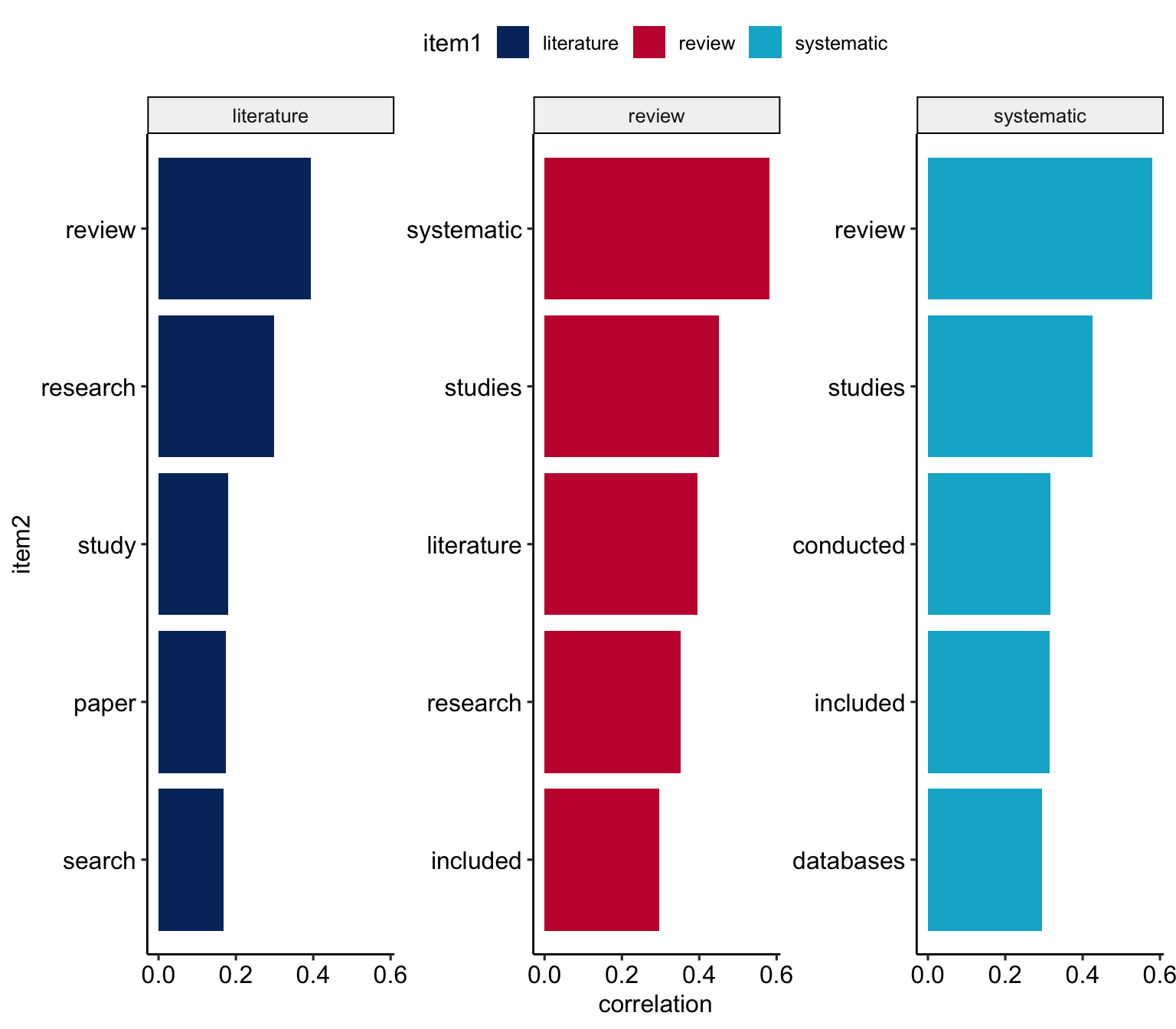
Let’s talk about sentiments
Dictionary based approach of text analysis
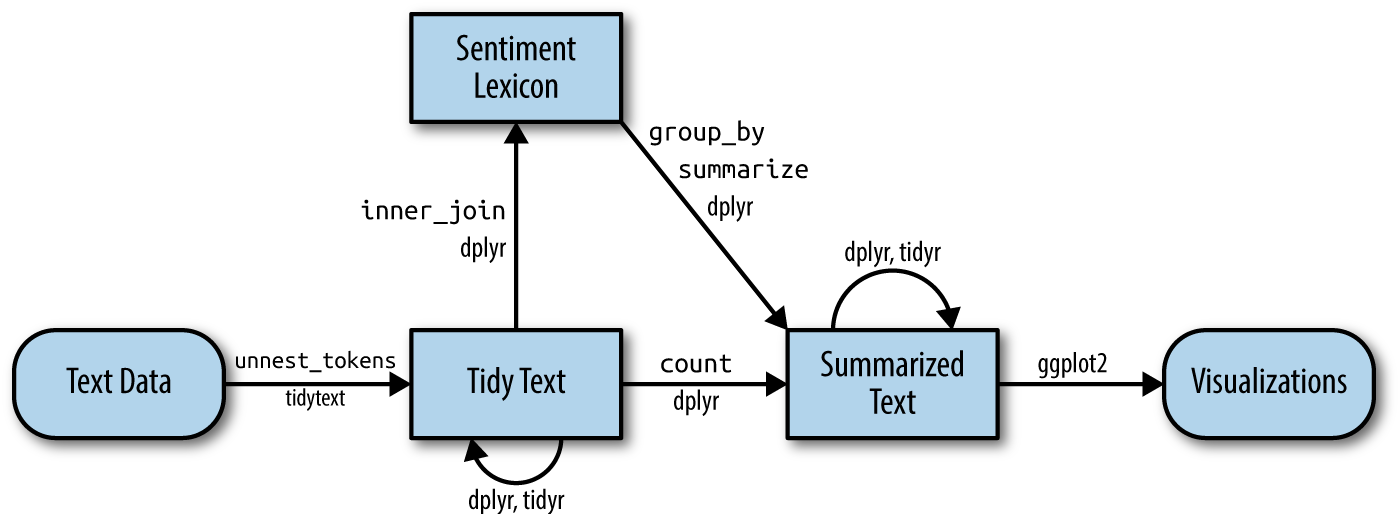
Atteveldt et al. (2021) argue that sentiment, in fact, are quite a complex concepts that are often hard to capture with dictionaries.
Über die Bedeutung von “positiv;negativ”
Die häufigsten “positiven” und “negativen” Wörter in den Abstracts
review_sentiment_count <- review_tidy %>%
inner_join(
get_sentiments("bing"),
by = c("text" = "word"),
relationship = "many-to-many") %>%
count(text, sentiment)
# Preview
review_sentiment_count %>%
group_by(sentiment) %>%
slice_max(n, n = 10) %>%
ungroup() %>%
mutate(text = reorder(text, n)) %>%
ggplot(aes(n, text, fill = sentiment)) +
geom_col(show.legend = FALSE) +
facet_wrap(
~sentiment, scales = "free_y") +
labs(x = "Contribution to sentiment",
y = NULL) +
scale_fill_manual(
values = c("#C50F3C", "#007900")) +
theme_pubr()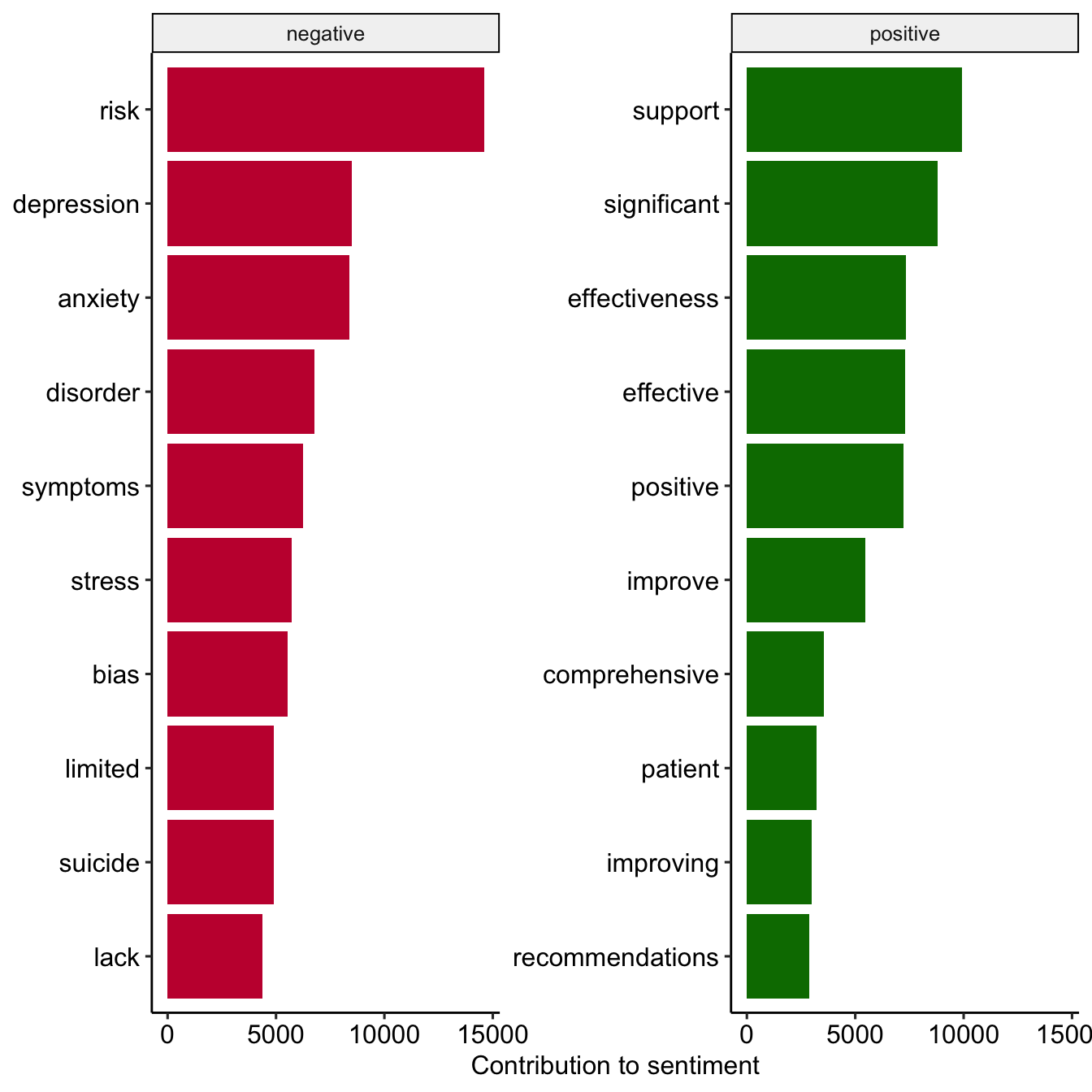
Anreicherung der Daten
Verknüpfung des Sentiemnt (Scores) mit den Abstracts
review_sentiment <- review_tidy %>%
inner_join(
get_sentiments("bing"),
by = c("text" = "word"),
relationship = "many-to-many") %>%
count(id, sentiment) %>%
pivot_wider(names_from = sentiment, values_from = n, values_fill = 0) %>%
mutate(sentiment = positive - negative)
# Check
review_sentiment # A tibble: 35,710 × 4
id negative positive sentiment
<chr> <int> <int> <int>
1 https://openalex.org/W1000529773 2 2 0
2 https://openalex.org/W1006561082 0 1 1
3 https://openalex.org/W100685805 4 15 11
4 https://openalex.org/W1007410967 0 7 7
5 https://openalex.org/W1008209175 8 1 -7
6 https://openalex.org/W1009104829 2 4 2
7 https://openalex.org/W1009607471 15 8 -7
8 https://openalex.org/W1031503832 13 6 -7
9 https://openalex.org/W1035654938 10 5 -5
10 https://openalex.org/W1044055445 5 0 -5
# ℹ 35,700 more rowsNeutral, mit einem leicht “negativen” Unterton
Verteilung des Sentiment (Scores) in den Abstracts
[1] 0.4858737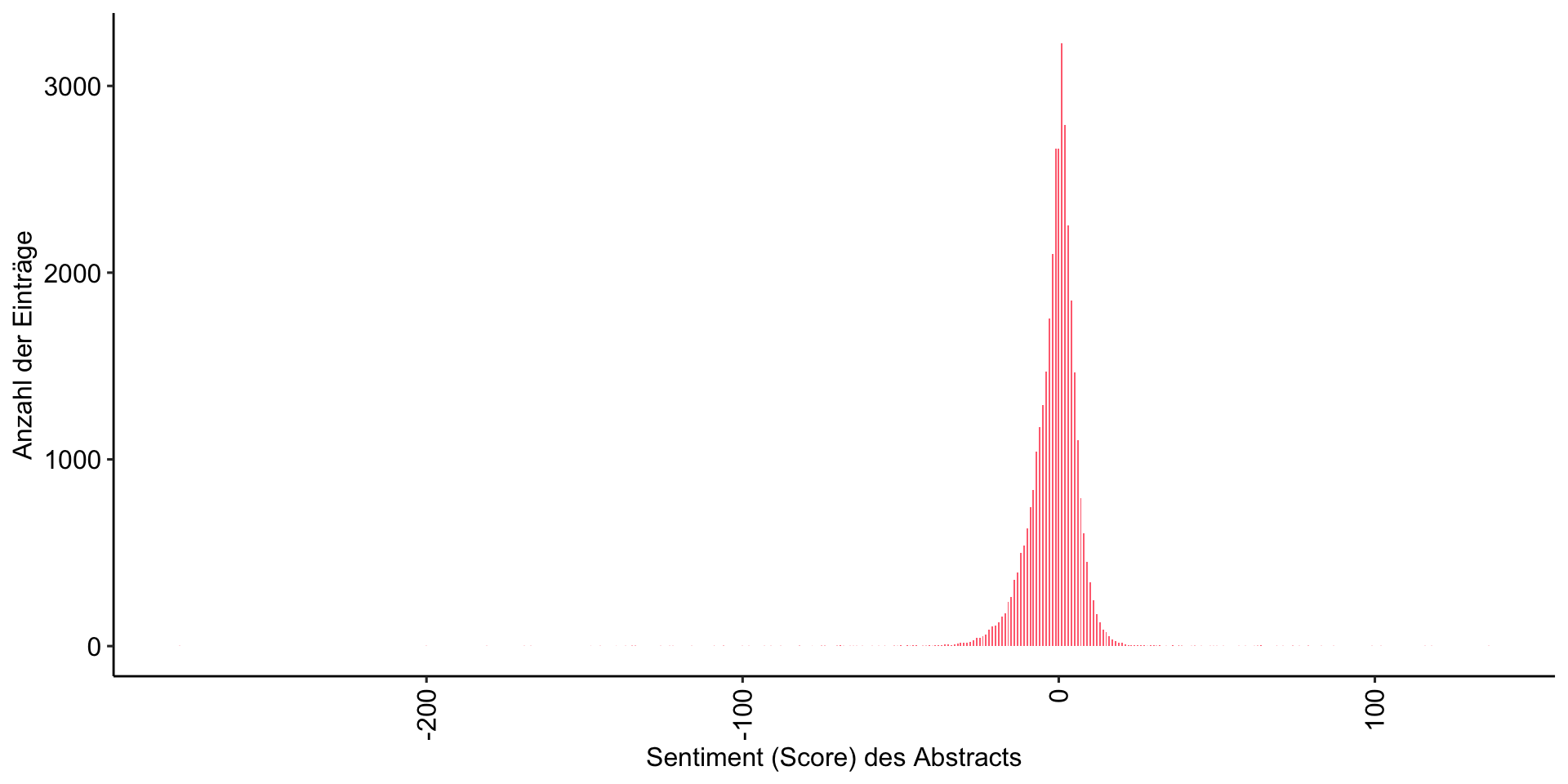
Keep it neutral
Entwicklung des Sentiment (Scores) der Abstracts im Zeitverlauf
Expand for full code
# Create first graph
g1 <- review_works_correct %>%
filter(id %in% review_sentiment$id) %>%
left_join(review_sentiment, by = join_by(id)) %>%
sjmisc::rec(
sentiment,
rec = "min:-2=negative; -1:1=neutral; 2:max=positive") %>%
ggplot(aes(x = publication_year_fct, fill = as.factor(sentiment_r))) +
geom_bar() +
labs(
x = "",
y = "Anzahl der Einträge",
fill = "Sentiment (Score)") +
scale_fill_manual(values = c("#C50F3C", "#90A0AF", "#007900")) +
theme_pubr()
#theme(axis.text.x = element_text(angle = 90, vjust = 0.5, hjust=1))
# Create second graph
g2 <- review_works_correct %>%
filter(id %in% review_sentiment$id) %>%
left_join(review_sentiment, by = join_by(id)) %>%
sjmisc::rec(
sentiment,
rec = "min:-2=negative; -1:1=neutral; 2:max=positive") %>%
ggplot(aes(x = publication_year_fct, fill = as.factor(sentiment_r))) +
geom_bar(position = "fill") +
labs(
x = "",
y = "Anteil der Einträge",
fill = "Sentiment (Score)") +
scale_fill_manual(values = c("#C50F3C", "#90A0AF", "#007D29")) +
theme_pubr()
# COMBINE GRPAHS
ggarrange(g1, g2,
nrow = 1, ncol = 2,
align = "hv",
common.legend = TRUE) 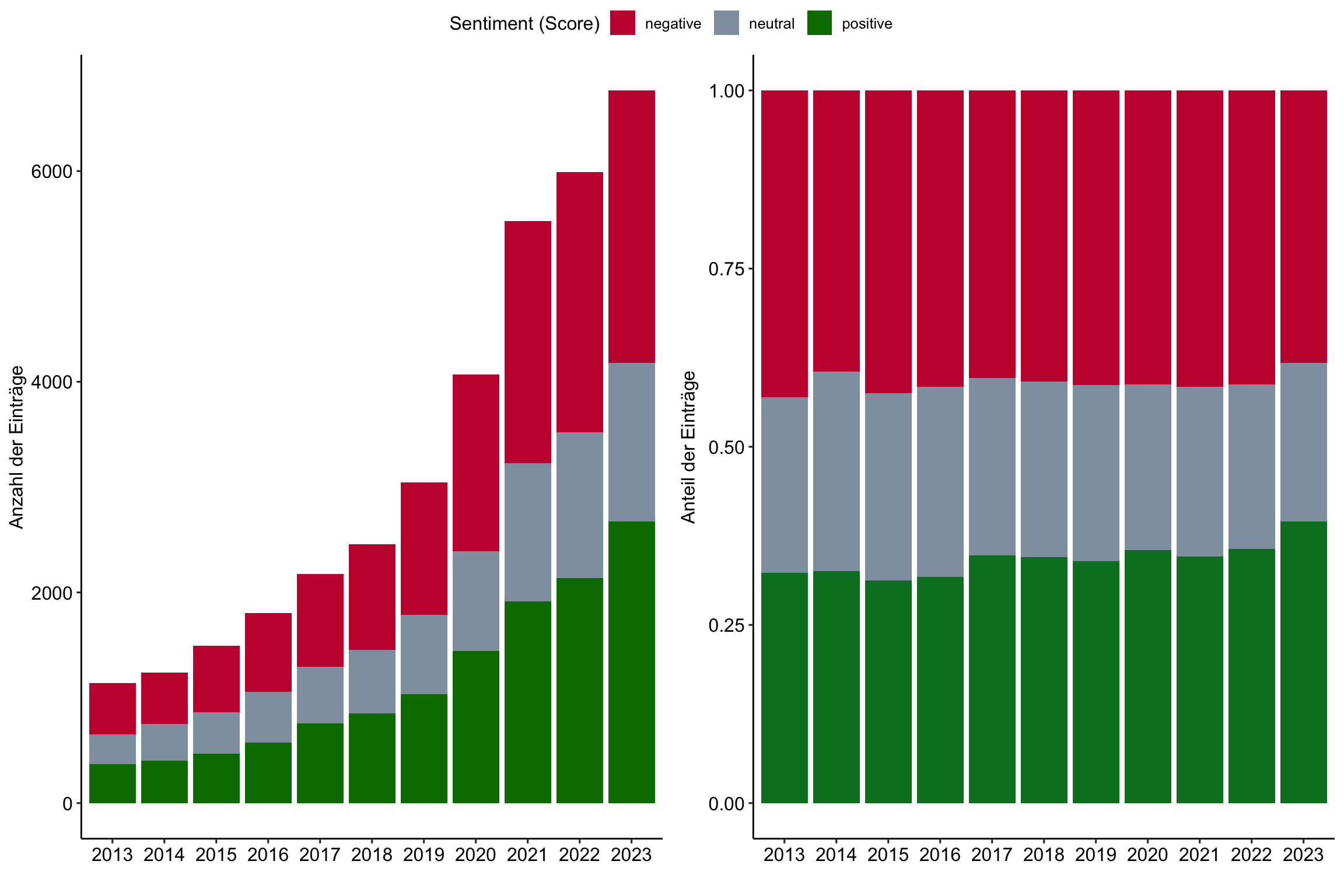
📋 Hands on working with R
Verschiedene R-Übungsaufgaben zum Inhalt der heutigen Sitzung
🧪 And now … you: Wiederholung
Next Steps: Wiederholung der R-Grundlagen an OpenAlex-Daten
- Laden Sie die auf StudOn bereitgestellten Dateien für die Sitzungen herunter
- Laden Sie die .zip-Datei in Ihren RStudio Workspace
- Navigieren Sie zu dem Ordner, in dem die Datei
ps_24_binder.Rprojliegt. Öffnen Sie diese Datei mit einem Doppelklick. Nur dadurch ist gewährleistet, dass alle Dependencies korrekt funktionieren. - Öffnen Sie die Datei
exercise-08.qmdim Ordnerexercisesund lesen Sie sich gründlich die Anweisungen durch. - Tipp: Sie finden alle in den Folien verwendeten Code-Bausteine in der Datei showcase.qmd (für den “rohen” Code) oder showcase.html (mit gerenderten Ausgaben).
